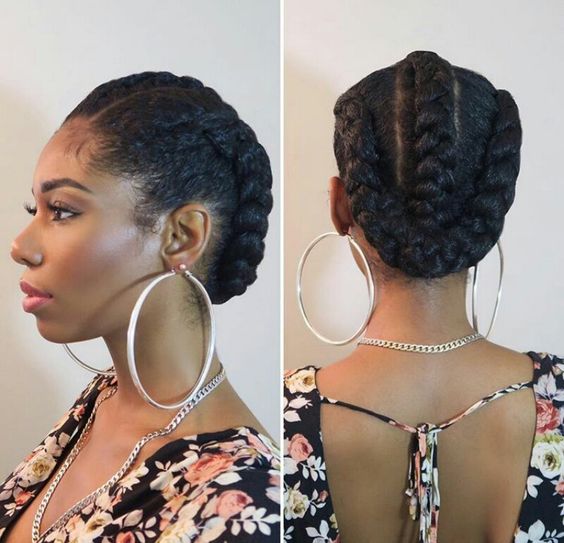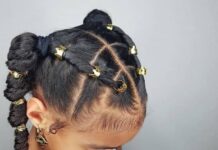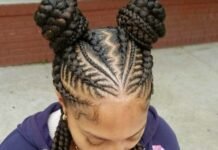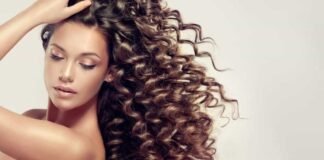Heat Damage and Natural Hair: How to Get Curl Pattern Back
Heat styling is tempting if you like to wear your natural hair in a variety of styles, but too much time with high temp tools can lead to dreaded heat damage. If your natural curl pattern has changed due to overuse of heat, read on to learn about ways to breathe new life into your stressed out strands.
1What causes heat damage?

Repeated use of heat styling tools at high temperatures will eventually cause heat damage to natural hair. Flat irons, curling irons, and blow dryers are all potential culprits, especially when used on their highest settings or without a heat protectant product. Occasional use of these tools isn’t likely to cause permanent damage to your natural hair, but daily use repeated over months or years can eventually change the structural bonds of your hair, destroying natural curl pattern and ravaging cuticles.
2Signs of heat damage on your natural hair
- Changes to natural curl pattern – Your hair may appear straight without the use of styling tools, or could have a changed curl pattern that’s loose or uneven.
- Split ends – Strands that split off into two or more different directions is one of the most common signs of heat damage.
- Loss of shine – Repeated heat exposure can cause strands to be more porous, which not only makes them weaker but also causes a dull appearance.
- Dryness – Do your strands feel like straw even after being well conditioned? If your previously hydrated mane is feeling all dried out, heat damage could be to blame.
- Tangles and breakage – Heat damaged hair tends to break and tangle instead of stretching as you manipulate it. An increase in the number of knots in your hair or broken strands during styling point to an unhealthy head of hair.
3Treatments for heat damage and how to get natural curls back after heat damage
Cut the heat – It may be obvious, but the first thing that heat damaged hair needs is a break from the high temps that got you into this mess. This means no blowdryer, flat iron or curling iron for 6-12 months. If you’re serious about restoring your natural curl pattern, now is a great time to try out some no heat curling options.
Moisturize – Heat damaged hair can gain huge benefits from extra moisturizing treatments. Get in the habit of applying a moisturizing cream on damp hair after it’s been washed, which will help prevent some of the dryness that comes along with heat damaged hair.
Deep condition – Deep conditioning treatments bring more intense moisture than regular conditioner. Most natural hair benefits from weekly deep conditioning regardless of if its damaged, but you can up this frequency when dealing with heat damaged hair.
Shampoo less often – Every time you shampoo your hair, you’re stripping it of natural oils. and promoting dryness. If you were washing your hair frequently in between bouts of heat styling, it’s time to break the shampoo habit.
Sulfate-free shampoo – When you do shampoo your hair, stick to sulfate-free products that won’t strip your damaged hair of its natural oils.
Co-washing – The co-washing method is a great alternative to frequently shampooing your hair, and involves “washing” your hair with conditioner instead. Instead of using a regular conditioner that’s meant to follow traditional shampoo, purchase a cleansing conditioner that’s formulated without silicones.
Apple cider vinegar – When you’re shampooing less frequently, you’ll still likely need an extra clarifying cleanse every now and then. Rinsing your hair and scalp with apple cider vinegar diluted in a 1:1 ratio with water will help to clear away built up product and leave your hair looking refreshed without drying it out.
Protein treatments – A good protein treatment is a great way to replenish damaged natural curls. They work by filling in porous strands and strengthening the hair’s cuticle, and most are also deep conditioning treatments that will leave your hair feeling softer and more supple afterwards.
Cut damaged ends – To some this is an absolute last resort, but it’s highly recommended you cut your heat damaged hair if split ends are visible. Without trimming, these splits can travel farther up the hair’s shaft further damaging each strand. A small trim now could save you from having to cut more hair in a few months.
Hairstyles for heat damaged hair
Now that heat styling is off the table, you might be at a loss as to how to style your hair. These are some of our favorite styles for creating curls and looking great without using high temperatures.
4Bantu Knot Out

One of our favorite methods for putting curls back into damaged and stressed strands, a bantu knot out provides defined, springy texture to your hair. Add a moisturizing curl milk to your damp strands before twisting bantu knots into position. You can wear these knots for a day or overnight, then unravel the following morning to reveal these bouncy curls.
5Perm Rod Curls

Another heat-free way to put defined curls in your natural hair, perm rods allow you to create a uniform texture from roots to ends.
6Faux Locs

If you’re looking for a protective style to keep your heat damaged hair under wraps for a few weeks at a time, faux locs are a trendy style that gives you the option of lengthening your hair and tying out new colors and accessories.
7Twist Out

Try a classic twist out to put the curl back in your heat damaged hair. Using perm rods at the ends of your twists allows you to get an even texture right to the ends, which is especially important when working with heat damaged hair that has an uneven curl pattern.
8Twin Braids

Putting your natural hair in dutch or Ghana braids is an easy way to keep it safe and secure, and extensions can be added to create an extra long look without hurting your mane.
9No Heat Curlformers

Curlformers are an incredible product for giving you a defined texture with minimal effort, and work on every hair type from fine and straight to coarse and curly.
10Havana Twists

Whether you choose to work just with your natural hair or add extensions, Havana twists are a fun protective style that’s generally easier to install than faux locs or box braids. Best of all, this is a lighter protective style that will take it easier on your edges and prevent further breakage.
11Braid Out

If your curl pattern has been seriously destroyed by heat damage, twisted styles might not be tight enough to create the curls you’re looking for. In this case, try a braid out style to put a fun wavy look back in your hair.
12Crochet Braids Curls

Crochet braids can give you a taste of the curls you’ve been missing, and are surprisingly easy to install on your own.
13Protective Hairstyles – Goddess Braids

If your natural hair is on the longer side, goddess braids are a chic way to wear your hair in an updo without the need for any heat styling tools. If you’re sure to moisturize thoroughly you should be able stretch this protective style for several days.
14Wash and Go

Depending on how heat damaged your hair is, a wash and go style can be a good way to get out of the habit of heat styling your hair. This method allows you to see how your curl pattern may have changed due to heat damage, and lets you apply leave-in moisturizer more frequently than protective styles that keep your natural hair under wraps.
15Box Braids

One of the most popular protectives styles, box braids can be customized to your heart’s desire. To prevent breakage when wearing box braids, opt for lighter synthetic hair and part your hair in larger sections.
Best products for heat damaged natural hair
Taking care of heat damaged hair can be overwhelming, but these tried and tested products are a great start to helping you establish a routine to nourish and repair.
16As I Am Coconut CoWash Cleansing Conditioner

If you’re looking for the perfect product to kickstart a new co-wash routine,As I Am Coconut CoWash offers an incredibly nourishing cleanse at an affordable price. Coconut and castor oil give your heat damaged hair the deep moisture it needs without weighing strands down. And because it’s formulated without silicone, you can use this each time you wash your hair in place of a traditional shampoo. Apply coconut co-wash to wet hair, then brush through with your fingers or a wide tooth comb before rinsing out.
What we love:
- Moisturizes and detangles.
- Reasonable cost.
Dislikes:
- Packaging can be awkward in the shower.
17ApHogee Keratin 2 Minute Reconstructor

Ready to fill in the gaps of your dried out, heat damaged hair? ApHogee’s Keratin Reconstructor is a powerful protein treatment that’s specifically designed for natural hair that’s been damaged by chemicals and heat. Formulated with hydrolyzed protein, amino acids, and nourishing oils, it only takes an extra 2 minutes to give your damaged hair a big hand in helping to heal. Apply keratin reconstructor to cleansed and towel-dried hair, cover with plastic cap or towel for two minutes, then rinse and style as normal. This protein treatment can be used weekly, and works well on hair that’s been chemically treated or colored.
What we love:
- Leaves hair instantly softer.
- Reasonable price.
Dislikes:
- Doesn’t smell great.
18Shea Moisture Strengthen & Grow Leave-In Conditioner

A leave-in conditioner may have been part of your hair routine before heat damage occurred, but it’s especially important to continue on with as you look to repair your hair. If your hair has been severely dried out after repeated heat styling, this leave-in conditioner from Shea Moisture will make an excellent addition to your daily moisturizing routine.
What we love:
- Leave-in that can be used daily.
- Lightweight moisture for fine hair.
Dislikes:
- Can feel greasy in fine hair.
19DevaCurl Heaven in Hair Intense Moisture Treatment

If you’ve got some extra time to pamper your heat damaged hair, 30 minutes with DevaCurl’s Heaven in Hair will leave your hair softened without weighing it down. Women with damaged hair that’s thick and coarsely texture are impressed with the staying power of this product, and its thick consistency adheres to even the heaviest of manes. To use, coat damp hair thoroughly in the product, then cover with a cap and leave for 15-30 minutes before rinsing and styling as usual.
What we love:
- Thick consistency
- Great for coarse/thick hair
Dislikes:
- Expensive for product size.
20Lottabody Moisturize Me Curl & Style Milk

As you get used to styling your hair without heat, it’s helpful to find styling products that provide moisture during the final steps of your haircare regimen. Lottabody Moisturize Me is a moisturizing milk that gives shine as well as hold. A little bit of this product goes a long way, and you can apply it to your damp hair before setting strands in a twist out or braid out style. After setting overnight, Moisturize Me will help your heat damaged hair retain the desired shape without leaving it feeling greasy or crunchy, but should be used sparingly on particularly fine hair.
What we love:
- Smells great.
- Provides hold and shine.
Dislikes:
- Can weigh down fine hair.
21How to prevent heat damage to natural hair

- Get in the habit of moisturizing and deep conditioning before damage occurs.
- Use a heat protectant spray every time you’re using hot tools on your hair. Even occasional heat styling can cause damage if you’re not properly prepping your strands.
- Start with low temperatures and work your way up. Temperatures higher than 450 degrees will almost certainly burn your hair, but this can happen with less heat depending on the texture of your hair.
- To avoid overdoing it, limit heat styling to once weekly and alternate with protective styles to give your hair a break from high temperatures and too much manipulation.
22How to grow out heat damaged natural hair
- Stop using heat styling tools.
- Moisturize frequently and do weekly protein treatments.
- Embrace heatless and protective styles.
- Trim your hair frequently to prevent further splitting and encourage healthy regrowth.











Thank you this information I am trying to treat my heat damage from almost six months ago. Just have a little bit to go. Great hair styles to consider.